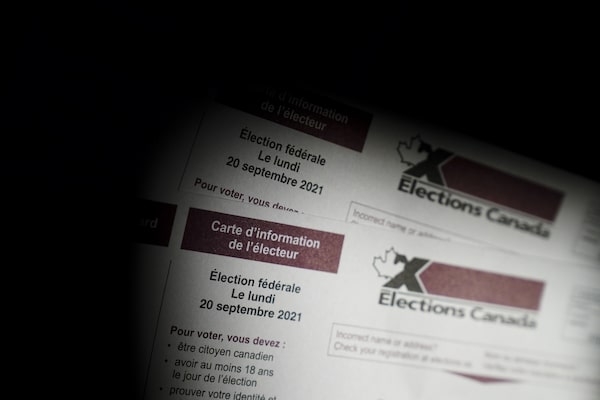
An Elections Canada voter information card. The pandemic election campaign didn’t swing folks behind one vision of the future or another, writes Campbell Clark.Sean Kilpatrick/The Canadian Press
After 18 months of pandemic and everyday talk about what parts of life have changed forever, you would think that a national election campaign would have featured politicians making compelling cases about the direction for the country through a crisis and beyond.
Yet as voting day 2021 arrives, that’s the thing that’s still missing. This was a campaign where party leaders focused so much on why you shouldn’t vote for the other candidate that they largely neglected to provide a good reason to vote for them. In a sense, they have left voters alone to find one.
There are distinctions between parties and leaders, substantial ones, and on election day it’s a good idea to remember that the blessing of democracy is to be able to choose an option that imperfectly brings the country closer to where you want it to go.
But it already seems clear that the electorate remains fragmented, the public in parts angrier, and the pandemic election campaign didn’t swing folks behind one vision of the future or another. Maybe that’s partly because for all the tactics, a vision was hard to see.
Canada’s 2021 federal election platform guide: compare where the parties stand on top issues
Liberal Leader Justin Trudeau started the campaign Aug. 15 telling us that this is perhaps the most “pivotal” moment the country has faced since the Second World War, but he struggled to make clear what point the future turned on. Conservative Leader Erin O’Toole talked overwhelmingly about having a plan and sparingly about what was in it.
Just look at the closing arguments in the final few days.
On Sunday, Mr. Trudeau spent a lot of his time attacking Mr. O’Toole for not ensuring Conservative candidates are vaccinated, and warning that the Tory Leader would make the same pandemic mistakes as Alberta Premier Jason Kenney – which was at least more specific than the warning that the Conservatives will “take us backward.”
Mr. O’Toole has spent days, and lots of campaign-ad money, telling voters not to “reward” Mr. Trudeau for calling an election in a pandemic – as though the whole voting exercise is about meting out bouquets and brickbats rather than choosing a government to set the course of the country.
You might have expected NDP Leader Jagmeet Singh, the heir to the late Jack Layton’s upbeat style, to take a different approach. But he spent much of the campaign talking about Mr. Trudeau as a disappointment who says the right things but doesn’t do them, as he did Sunday at a press conference in Burnaby, B.C.
Many political strategists will tell you that “contrast” – knocking your opponent – works. Yet the leaders didn’t focus enough on their own side of the ledger.
And when they did, it was sometimes baffling.
Mr. O’Toole did have some major proposals that he didn’t say much about. He spent the first two weeks of the campaign talking about his economic recovery plan, but not a lot about the tax credits for investors in it. He said little about his biggest platform item, a $24-billion promise to double the Canada Workers Benefit for low-income workers. Why play down the centrepieces of your own platform?
Mr. Trudeau used a variation (Forward for Everyone) of the slogan that didn’t work for him in 2019, and came out of the gates talking about vaccination mandates to get through the pandemic and back to work, but didn’t manage to connect the dots to postpandemic proposals such as the $10-a-day child-care program, which encourages a larger work force.
The NDP captured some attention pushing the idea of taxing the ultrarich, but strangely, Mr. Singh was less effective in painting a picture of the future the NDP would bring to Canada, even though it would ostensibly include fully public long-term care, pharmacare, dental care and the largest permanent expansion of federal government spending in decades.
Of course, all parties think they have reason to focus on wedge issues. Some might regret it. On aggregate, it seems likely it will produce wedge results.
There are no signs of a broad groundswell for any party, or dramatic swing to any vision. The most visible change has been a bulge of sometimes conspiracy-tinged anger, expressed by protesters about vaccine mandates and other things, and what appears to be a bump for Maxime Bernier’s People’s Party.
For many Canadians, inspiration won’t have been easy to find in this campaign. The good news is that what’s left still counts on the bottom line of democracy: picking the candidate closest to where you want the country to go.
Follow the party leaders and where they stand on the issues this election campaign by signing up for our Morning or Evening Update newsletters.
For subscribers only: Get exclusive political news and analysis by signing up for the Politics Briefing.
 Campbell Clark
Campbell Clark